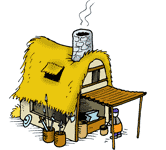
The blacksmith upgrades a troop’s base attack value. Every level of upgrade increases the attack points by about 1.5 percent. The 1.5 percent is only a rough guide. A fully upgraded unit at level 20 has a 35 percent increase in attack power.
The upgrade applies to troops trained from the same village. So an upgrade done in village A will not affect troops trained from village B.
Once a unit is upgraded, the upgrade will automatically be applied to all troops trained before and after the upgrade.
Once troops are upgraded, the blacksmith can be demolished and troops will still carry the upgraded levels. If a village is conquered, all upgrades are lost.
Since the blacksmith becomes redundant once upgrades are complete, it can be demolished to make room for other more important structures. However, a fully upgraded blacksmith generates 77 culture points. That is only a decent amount of culture points, so you may keep it for culture point generation if you don’t need the space.
A common question is whether upgrades are worth it? The answer is yes, definitely. But only for offensive units.
All offense troops should be upgraded to the maximum. Scouts should be upgraded only in the scout village.
The following troops should be upgraded:
| Teuton | : axeman, scout, teutonic knight, ram, catapult | |
| Roman | : imperian, Equites Legati, Equites Caesaris, ram, catapult | |
| Gaul | : swordsman, pathfinder, Haeduan, ram, trebuchet |
These units should be upgraded only in the offense village.
The Teuton scout, Roman Equites Legati and Gaul pathfinder should be upgraded only in the scout village.
It’s especially important to upgrade rams and catas because they do more damage against walls and buildings.

Should the brewery be considered to increase attack power?
The brewery is only effective if you are not catting or chiefing. But a full upgraded brewery with a festival will affect the attack power of a large army a great deal.